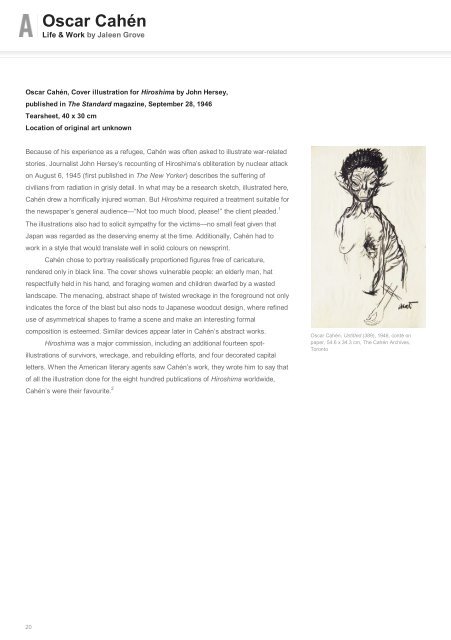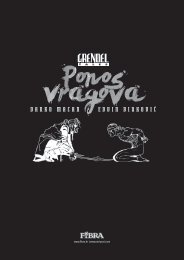Oscar Cahén
Art-Canada-Institute_Oscar-Cah%C3%A9n
Art-Canada-Institute_Oscar-Cah%C3%A9n
You also want an ePaper? Increase the reach of your titles
YUMPU automatically turns print PDFs into web optimized ePapers that Google loves.
<strong>Oscar</strong> <strong>Cahén</strong><br />
Life & Work by Jaleen Grove<br />
<strong>Oscar</strong> <strong>Cahén</strong>, Cover illustration for Hiroshima by John Hersey,<br />
published in The Standard magazine, September 28, 1946<br />
Tearsheet, 40 x 30 cm<br />
Location of original art unknown<br />
Because of his experience as a refugee, <strong>Cahén</strong> was often asked to illustrate war-related<br />
stories. Journalist John Hersey’s recounting of Hiroshima’s obliteration by nuclear attack<br />
on August 6, 1945 (first published in The New Yorker) describes the suffering of<br />
civilians from radiation in grisly detail. In what may be a research sketch, illustrated here,<br />
<strong>Cahén</strong> drew a horrifically injured woman. But Hiroshima required a treatment suitable for<br />
the newspaper’s general audience—“Not too much blood, please!” the client pleaded.<br />
The illustrations also had to solicit sympathy for the victims—no small feat given that<br />
Japan was regarded as the deserving enemy at the time. Additionally, <strong>Cahén</strong> had to<br />
work in a style that would translate well in solid colours on newsprint.<br />
<strong>Cahén</strong> chose to portray realistically proportioned figures free of caricature,<br />
rendered only in black line. The cover shows vulnerable people: an elderly man, hat<br />
respectfully held in his hand, and foraging women and children dwarfed by a wasted<br />
landscape. The menacing, abstract shape of twisted wreckage in the foreground not only<br />
indicates the force of the blast but also nods to Japanese woodcut design, where refined<br />
use of asymmetrical shapes to frame a scene and make an interesting formal<br />
composition is esteemed. Similar devices appear later in <strong>Cahén</strong>’s abstract works.<br />
Hiroshima was a major commission, including an additional fourteen spotillustrations<br />
of survivors, wreckage, and rebuilding efforts, and four decorated capital<br />
letters. When the American literary agents saw <strong>Cahén</strong>’s work, they wrote him to say that<br />
of all the illustration done for the eight hundred publications of Hiroshima worldwide,<br />
<strong>Cahén</strong>’s were their favourite.<br />
2<br />
1<br />
<strong>Oscar</strong> <strong>Cahén</strong>, Untitled (389), 1946, conté on<br />
paper, 54.6 x 34.3 cm, The <strong>Cahén</strong> Archives,<br />
Toronto<br />
Illustration for “The Californian’s Tale” 1947<br />
20



